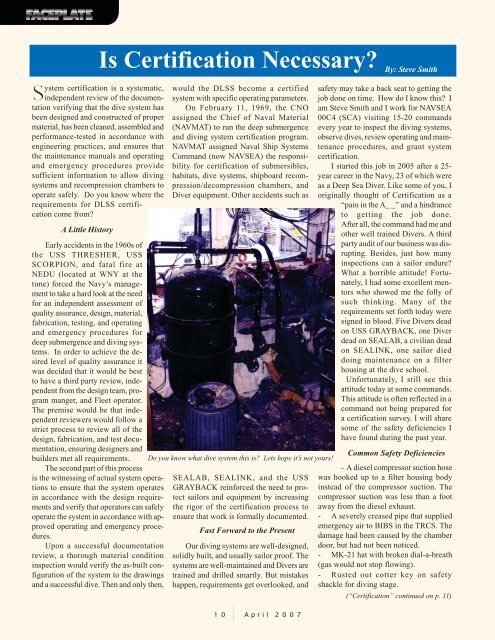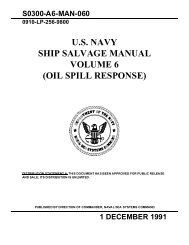April 2007 - Supervisor of Salvage and Diving
April 2007 - Supervisor of Salvage and Diving
April 2007 - Supervisor of Salvage and Diving
You also want an ePaper? Increase the reach of your titles
YUMPU automatically turns print PDFs into web optimized ePapers that Google loves.
System certification is a systematic,<br />
independent review <strong>of</strong> the documentation<br />
verifying that the dive system has<br />
been designed <strong>and</strong> constructed <strong>of</strong> proper<br />
material, has been cleaned, assembled <strong>and</strong><br />
performance-tested in accordance with<br />
engineering practices, <strong>and</strong> ensures that<br />
the maintenance manuals <strong>and</strong> operating<br />
<strong>and</strong> emergency procedures provide<br />
sufficient information to allow diving<br />
systems <strong>and</strong> recompression chambers to<br />
operate safely. Do you know where the<br />
requirements for DLSS certification<br />
come from?<br />
A Little History<br />
Early accidents in the 1960s <strong>of</strong><br />
the USS THRESHER, USS<br />
SCORPION, <strong>and</strong> fatal fire at<br />
NEDU (located at WNY at the<br />
time) forced the Navy’s management<br />
to take a hard look at the need<br />
for an independent assessment <strong>of</strong><br />
quality assurance, design, material,<br />
fabrication, testing, <strong>and</strong> operating<br />
<strong>and</strong> emergency procedures for<br />
deep submergence <strong>and</strong> diving systems.<br />
In order to achieve the desired<br />
level <strong>of</strong> quality assurance it<br />
was decided that it would be best<br />
to have a third party review, independent<br />
from the design team, program<br />
manger, <strong>and</strong> Fleet operator.<br />
The premise would be that independent<br />
reviewers would follow a<br />
strict process to review all <strong>of</strong> the<br />
design, fabrication, <strong>and</strong> test documentation,<br />
ensuring designers <strong>and</strong><br />
builders met all requirements.<br />
The second part <strong>of</strong> this process<br />
is the witnessing <strong>of</strong> actual system operations<br />
to ensure that the system operates<br />
in accordance with the design requirements<br />
<strong>and</strong> verify that operators can safely<br />
operate the system in accordance with approved<br />
operating <strong>and</strong> emergency procedures.<br />
Upon a successful documentation<br />
review, a thorough material condition<br />
inspection would verify the as-built configuration<br />
<strong>of</strong> the system to the drawings<br />
<strong>and</strong> a successful dive. Then <strong>and</strong> only then,<br />
Is Certification Necessary?<br />
would the DLSS become a certified<br />
system with specific operating parameters.<br />
On February 11, 1969, the CNO<br />
assigned the Chief <strong>of</strong> Naval Material<br />
(NAVMAT) to run the deep submergence<br />
<strong>and</strong> diving system certification program.<br />
NAVMAT assigned Naval Ship Systems<br />
Comm<strong>and</strong> (now NAVSEA) the responsibility<br />
for certification <strong>of</strong> submersibles,<br />
habitats, dive systems, shipboard recompression/decompression<br />
chambers, <strong>and</strong><br />
Diver equipment. Other accidents such as<br />
Do you know what dive system this is? Lets hope it’s not yours!<br />
SEALAB, SEALINK, <strong>and</strong> the USS<br />
GRAYBACK reinforced the need to protect<br />
sailors <strong>and</strong> equipment by increasing<br />
the rigor <strong>of</strong> the certification process to<br />
ensure that work is formally documented.<br />
Fast Forward to the Present<br />
Our diving systems are well-designed,<br />
solidly built, <strong>and</strong> usually sailor pro<strong>of</strong>. The<br />
systems are well-maintained <strong>and</strong> Divers are<br />
trained <strong>and</strong> drilled smartly. But mistakes<br />
happen, requirements get overlooked, <strong>and</strong><br />
By: Steve Smith<br />
safety may take a back seat to getting the<br />
job done on time. How do I know this? I<br />
am Steve Smith <strong>and</strong> I work for NAVSEA<br />
00C4 (SCA) visiting 15-20 comm<strong>and</strong>s<br />
every year to inspect the diving systems,<br />
observe dives, review operating <strong>and</strong> maintenance<br />
procedures, <strong>and</strong> grant system<br />
certification.<br />
I started this job in 2005 after a 25-<br />
year career in the Navy, 23 <strong>of</strong> which were<br />
as a Deep Sea Diver. Like some <strong>of</strong> you, I<br />
originally thought <strong>of</strong> Certification as a<br />
“pain in the A_ _” <strong>and</strong> a hindrance<br />
to getting the job done.<br />
After all, the comm<strong>and</strong> had me <strong>and</strong><br />
other well trained Divers. A third<br />
party audit <strong>of</strong> our business was disrupting.<br />
Besides, just how many<br />
inspections can a sailor endure?<br />
What a horrible attitude! Fortunately,<br />
I had some excellent mentors<br />
who showed me the folly <strong>of</strong><br />
such thinking. Many <strong>of</strong> the<br />
requirements set forth today were<br />
signed in blood. Five Divers dead<br />
on USS GRAYBACK, one Diver<br />
dead on SEALAB, a civilian dead<br />
on SEALINK, one sailor died<br />
doing maintenance on a filter<br />
housing at the dive school.<br />
Unfortunately, I still see this<br />
attitude today at some comm<strong>and</strong>s.<br />
This attitude is <strong>of</strong>ten reflected in a<br />
comm<strong>and</strong> not being prepared for<br />
a certification survey. I will share<br />
some <strong>of</strong> the safety deficiencies I<br />
have found during the past year.<br />
Common Safety Deficiencies<br />
- A diesel compressor suction hose<br />
was hooked up to a filter housing body<br />
instead <strong>of</strong> the compressor suction. The<br />
compressor suction was less than a foot<br />
away from the diesel exhaust.<br />
- A severely creased pipe that supplied<br />
emergency air to BIBS in the TRCS. The<br />
damage had been caused by the chamber<br />
door, but had not been noticed.<br />
- MK-21 hat with broken dial-a-breath<br />
(gas would not stop flowing).<br />
- Rusted out cotter key on safety<br />
shackle for diving stage.<br />
(“Certification” continued on p. 11)<br />
1 0 A p r i l 2 0 0 7

















